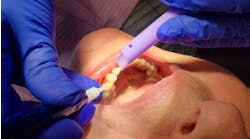DentistryIQ has published several articles that have gotten the attention of your dental colleagues over the last few weeks. In case you missed them, here are some quick takes.
Stop normalizing bleeding gums
The simple truth is that healthy gums don’t bleed. When we observe bleeding, we need to treat it. Sometimes this shift is challenging because we have tolerated bleeding for so long. But really, we have to do better.
We’ve heard the commercial about a little pink in the sink telling patients that it’s a sign of gingivitis. It is, yet it’s also easy to ignore the pink, even for clinicians. Often, we minimize or overlook bleeding at a patient’s preventive maintenance appointment. Whether it is bleeding upon probing or that gush of delayed bleeding while scaling, it needs our attention.
Gingival bleeding is the objective clinical sign we typically use to determine if inflammation is present. While patients with smoking or vaping habits may have suppressed bleeding, or those on blood thinners might have increased bleeding, generally, gathering a patient’s bleeding index is a valuable assessment tool to document the activity of disease present.
The observation of gingival bleeding demonstrates ulceration of the sulcular epithelium. This means there is a chronic oral wound in the pocket. These wounds fail to heal in a normal time frame and remain open, weeping sores that can lead to further oral and systemic complications. Can you imagine the urgency with which we’d treat these infected lesions if they weren’t hiding in a pocket? Read the full article.
Ozempic and dentistry: Implications for today’s clinicians
As the percentage of Americans struggling with obesity increases, so has the demand for weight-loss drugs like Ozempic. Here’s what you need to know about the direct implications these medications have in dentistry.
Approximately 70% of adults in the US struggle with obesity or are overweight, which has prompted a surge in prescriptions for weight-loss drugs. Originally developed for the treatment of type 2 diabetes, semaglutide—known under the brand names Ozempic, Rybelsus, and Wegovy—has exploded in popularity over the past few years for its dual role in targeting obesity and elevated blood sugar. In late 2023, the FDA added another tool to the weight-loss arsenal when they approved tirzepatide—known under the brand names Mounjaro and Zepbound—for chronic weight management.
During the last three months of 2022, health-care providers wrote more than 9 million prescriptions for weight-loss drugs. The number of prescriptions for semaglutide rose 150% over the past year, marking an 80% increase in written prescriptions per health-care provider. Since insurance coverage for weight-loss drugs isn’t a given, many people are paying for these drugs out-of-pocket.
Weight-loss drugs can have dental implications and point to systemic health issues. If your patients are taking any of these medications, you may need to adjust dosages of local anesthetics and analgesics or make other considerations regarding your dental treatment. Read the full article.
The "harmless-looking" white lip lesion that got ignored
Malignant lesions can be confusing to diagnose without a biopsy because some share etiologic factors. This lesion should not have been ignored.
A healthy 65-year-old male patient of record for several years presents for his recare/periodontal maintenance visit. He reports no concerns. A clinical head and neck exam reveals a white, flat, 5 mm x 5 mm irregular-bordered lesion on the lower labial tissue.
The lesion had been present for approximately two months, but the patient did not remember experiencing any trauma to the area. Specific etiology for the lesion is unknown. The area is not tender to palpation, and, for the most part, the patient has ignored the lesion.
Differentials include:
- Squamous cell carcinoma
- Actinic cheilitis/solar keratosis
- Leukoplakia
6 reasons not to ignore a child’s tongue-tie
A tongue-tie is more serious than just the inability to stick out the tongue and lick an ice cream cone. Here are six reasons why you shouldn’t ignore a tongue-tie.
It seems to be the newest trend in dentistry. Social media platforms are blowing up with videos, questions, and opinions on it. Members of neighborhood chat pages are starting to post: “Whose dentist can release my tongue-tie?” “Looking for an airway dentist.” “In search of a functional dentist.”
Most providers realize that airway dentistry and releasing a tongue restriction is not something new. Tongue-ties have been noted in historical documents, and even said to be mentioned in the Bible. Midwives would use a fingernail to release a tongue restriction in the 1600s when the frenotomy was widely unknown. Nevertheless, we know the condition of ankyloglossia has been around for thousands of years, but our patients do not. Not only do they want to know if they have a tongue-tie, but they want to know what it is and how it affects their health. Could their tongue-tie be the missing piece to the puzzle they have spent thousands of dollars in health-care bills on looking for a resolution? Read the full article.
“I hurt.” Solutions for musculoskeletal disorders among dental clinicians
Some studies report at least 77% of dental professionals suffer from MSDs. Whether you are new to pain or a chronic sufferer, these strategies can help you correct any muscular imbalances you may have.
The World Health Organization states that around 1.71 billion people around the world have musculoskeletal conditions. That’s 21% of the world’s population.
Musculoskeletal disorders (MSDs) may be defined as “a group of diseases and complaints that affect different structures of the musculoskeletal system, including the nerves, tendons, muscles, joints, ligaments, bones, blood vessels, and supporting structures such as intervertebral discs.”
Dentistry is not immune to these problems; in fact, some studies report at least 77% of dental professionals suffer from MSDs. MSDs can present differently depending on the role of the clinician. A 2018 study among dental professionals in Western countries reported 58.5% had neck pain, 56.4% had lower back pain, 43.1% had shoulder pain, and 41.1% had upper back pain. Another study found that dentists tend to report a higher prevalence of back and neck pain (36.3%–60.1% and 19.8%–85%, respectively), while dental hygienists suffer from more hand and wrist issues (60%–69.5%). How we use our bodies during work makes the biggest difference in the manifestation of pain. Read the full article.
Share these articles with your peers if they haven’t seen them and stay tuned for more content to help you in your career.







